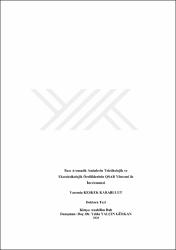| dc.contributor.advisor | Gürkan, Yelda Yalçın | |
| dc.contributor.author | Karabulut, Yasemin Keşkek | |
| dc.date.accessioned | 2022-04-06T06:49:21Z | |
| dc.date.available | 2022-04-06T06:49:21Z | |
| dc.date.issued | 2020 | |
| dc.identifier.uri | https://tez.yok.gov.tr/UlusalTezMerkezi/TezGoster?key=Eb5EkakJlp3olBdo_wNEGfnb612oIUzCXU-ps4J_6mzFF0sV_2jvQWZAsqzkGKu- | |
| dc.identifier.uri | https://hdl.handle.net/20.500.11776/4064 | |
| dc.description.abstract | Bu tez çalışmasında Aromatik aminlerin insan sağlığı ve çevreye olan etkilerinin incelenmesi amaçlanmıştır. Bu kapsamda, tekstil boyalarında yaygın olarak kullanılan hammaddeler 2,6-dikloro-4-nitroanilin, 2.6-dibromo -4-nitro anilin, N-Siyanoethylaasetoksietillanilin, 6-Metoksibenzotiazol-2-ylamin, 2-bromo-4,6-dinitroanilin, 4'-Aminoasetanilid, p-Asetanisidide, 3'-amino-, 3-Piridinkarbonitrile,1,2-dihidro-6-hidroksi-1,4-dimetil-2-okso, 2-siyano-4-nitroanilin, N,N-Dihidroksietil-3-amino-4-anisidin, N-Benzil,N-Metilanilin, N-Siyano Etil N-Benzil Aniline, 1,3,3-Trimetil-2-Metileneindolin ve bu hammaddelerden üretilen boyarmaddelerin (Disperse Brown 27-1, Disperse Brown 19, Disperse Orange 30, Red BS P/C, Dispers Blue 291, Dispers Yellow 27, Disperse Blue 823, Disperse Yellow 241, Disperse Blue 79, Basic Red 46, Orange 73-1, Basic Yellow 28) toksikolojik ve ekotoksikolojik özellikleri QSAR yöntemi kullanılarak incelenmiştir. Çalışmalar sonucunda, hammaddelerin ve ürünlerin genellikle orta tahriş edici oldukları bulunmuştur. İlgili hammaddeler genellikle göz tahriş edici özelliği gösterirken, ürünlerin tahriş edici özellik göstermediği görülmüştür. 25 aromatik aminin cilt hassaslaştırıcı özelliğinin var olduğu söylenebilir. 2,6-dibromo-4-nitro anilin, 6-metoksibenzotiazol-2-ylamin, 2-bromo-4,6-dinotroanilin hammaddeleri ve Dispers Brown 27-1, Dispers Brown 19 ve Dispers Blue 291 azo boyalarının mutajen etki gösterdiği görülmüştür. Bu tez çalışmasında aromatik aminlerin ekotoksikolojik özelliklerinin incelenmesi adına, hammadde olarak ele alınan 13 aromatik aminden 2-bromo-4,6-dinitroanilin aromatik amininin Daphnia'da en toksik olduğu görülmüştür. Dispers Blue 291 boyasının 0,0675 mg/L LC50 değeriyle, tüm yapılar aromatik aminler arasında balıklarda en yüksek toksisiteyi gösterdiği bulunmuştur. Biyolojik parçalanma açısından aromatik aminler incelendiğinde doğada parçalanma özelliği göstermediği bulunmuştur. Azo boyaların biyolojik parçalanma özelliği görülmemişken biyobirikimlerinin var olduğu görülmüştür. | en_US |
| dc.description.abstract | In this thesis, it is aimed to investigate the effects of aromatic amines on human health and environment. In this context, raw materials commonly used in textile dyes are 2,6-dichloro-4-nitroaniline, 2.6-dibromo -4-nitro aniline, N-Cyanoethylaacetoxyethylillanil, 6-Methoxybenzothiazole-2-ylamine, 2-bromo-4,6-dinitroaniline, 4'- Aminoacetanilide, p-Acetanicide, 3'-amino-, 3-Pyridinecarbonitrile, 1,2-dihydro-6-hydroxy-1,4-dimethyl-2-oxo, 2-cyano-4-nitroaniline, N, N-Dihydroxyethyl- 3-amino-4-anisidine, N-Benzyl, N-Methylaniline, N-Cyano Ethyl N-Benzyl Aniline, 1,3,3-Trimethyl-2-Methyleneeindoline and dyestuffs produced from these raw materials (Disperse Brown 27-1, Disperse Brown 19, Disperse Orange 30, Red BS P / C, Dispers Blue 291, Dispers Yellow 27, Disperse Blue 823, Disperse Yellow 241, Disperse Blue 79, Basic Red 46, Orange 73-1, Basic Yellow 28) were examined toxicological and ecotoxicological properties by QSAR method. As a result of the studies, it has been found that the raw materials and products are generally moderate irritants. While the related raw materials generally have eye irritant properties, the products have not been shown to be irritating properties. It can be said that 25 aromatic amines have skin sensitizing properties. The raw materials of 2,6-dibromo-4-nitro aniline, 6-methoxybenzothiazole-2-ylamine, 2-bromo-4,6-dinotroaniline and Dispers Brown 27-1, Dispers Brown 19 and Dispers Blue 291 of azo dyes have been found to be mutagenic. In this thesis, in order to examine the ecotoxicological properties of aromatic amines, 2-bromo-4,6-dinitroaniline aromatic amines, which are considered as raw materials, were found to be the most toxic in Daphnia. With a value of 0.0675 mg / L LC50 of Dispers Blue 291 dye, all structures were found to show the highest toxicity in fish among aromatic amines. When aromatic amines were examined in terms of biological degradation, it was found that it does not show degradation feature in nature. While biodegradation characteristics of azo dyes have not been observed, bioaccumulation has been observed. | en_US |
| dc.language.iso | tur | en_US |
| dc.publisher | Tekirdağ Namık Kemal Üniversitesi | en_US |
| dc.rights | info:eu-repo/semantics/openAccess | en_US |
| dc.subject | Kimya | en_US |
| dc.subject | Chemistry | en_US |
| dc.subject | Ekotoksikoloji | en_US |
| dc.subject | Ecotoxicology | en_US |
| dc.subject | Genotoksisite | en_US |
| dc.subject | Genotoxicity | en_US |
| dc.title | Bazı aromatik aminlerin toksikolojik ve ekotoksikolojik özelliklerinin QSAR yöntemi ile incelenmesi | en_US |
| dc.title.alternative | Investigation of some amine aromatic amines by QSAR method | en_US |
| dc.type | doctoralThesis | en_US |
| dc.department | Enstitüler, Fen Bilimleri Enstitüsü, Kimya Ana Bilim Dalı | en_US |
| dc.identifier.startpage | 1 | en_US |
| dc.identifier.endpage | 165 | en_US |
| dc.institutionauthor | Karabulut, Yasemin Keşkek | |
| dc.relation.publicationcategory | Tez | en_US |
| dc.identifier.yoktezid | 629691 | en_US |



















